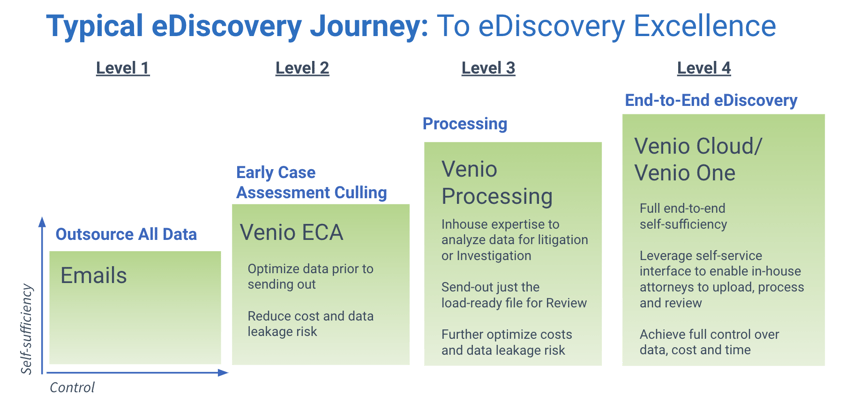From Ethan Eisner – CEO, Venio Systems

The eDiscovery industry will be greatly impacted in the years to come by three important factors: First, the amount of data and the complexity of that data will increase dramatically, creating challenges at every level. Second, this vast amount of data will change the nature of eDiscovery jobs — not eliminating them, but transforming them into something new. And finally, the roles of the organizations involved in eDiscovery, including legal service providers, law firms, and corporations, will change to meet the challenges of the data revolution and address the needs of their customers.
The growth of data
To discuss trends in eDiscovery, you have to start with trends in information. It’s safe to say we are all well aware of the massive increase in data with each passing day, week, month, and year. It’s hard to miss.
Putting that increase in context, though, leads to some shocking observations. For example, it’s estimated that in 2021, the amount of data produced and gathered worldwide will eclipse all the data produced in all of human history prior to 2017. That’s just four years to more than double all data produced previously. Not only that, but the variety of the data sources and the complexity of that data are changing every day. This includes, for example, social media posts, online meetings, instant messages, audio and video files, facial recognition records, and the various use of bots in data sets that at this point require human intervention to interpret.
That means you not only have a massive growth in data and information in general, but also a massive increase in the complexity of that data. Naturally, this creates very real challenges for all of us in the eDiscovery field.
The changing nature of jobs
These trends also impact job roles. There’s no question that jobs will change in the future, and in some ways we have already seen these changes begin to take shape. However, the challenge in the eDiscovery industry isn’t like the challenge faced by an industry like, say, truck driving. In that industry, jobs might literally just disappear. In the case of eDiscovery, the opposite looks to be true: more jobs will actually be created, and it’s simply the nature of those jobs that will change.
The question is, though, what does this mean for your business? Vast, previously unimaginable amounts of data, coming from new and not-yet-invented data sources, as well as complex relationships between different datasets will make eDiscovery expensive, highly complex, and beyond the capabilities of a human-only workforce. With that much data in that many forms, human beings will simply not be able to accomplish processing it in any realistic timeframe.
That being said, the eDiscovery industry stands ready for the next wave of innovation, despite the difficulties it faces. For example, on one hand, there are regulatory and compliance requirements designed to keep data secure behind the corporate firewall. But at the same time, there’s the reality that businesses sometimes need to share data with external service providers, witnesses, and law firms. When you combine that issue with the exponential growth in both the volume of data and its complexity that I mentioned earlier, the challenge becomes how to find the relevant information while minimizing risks and keeping expenses under control.
The role of AI
These new problems can’t be solved with old solutions, and that fact relates to why I was so excited to join Venio Systems. Venio’s founders have applied their deep expertise in the field of eDiscovery to develop sophisticated and forward-looking solutions for the problems the industry faces, and artificial intelligence is a crucial element in that vision.
I believe AI is fundamentally changing the industry far more and far faster than anything else ever has. A recent 2019 Gartner survey of 3,000 CIOs states that “AI is now considered the top disruptive technology,” and that’s surely the case in the eDiscovery industry. Things are moving at a lightning pace, and the sheer volume and diversity of content to cull through has reached a point where technology is an absolute necessity to keep up with and make sense of all that data. As things stand now, it’s simply no longer possible for humans to manually go through all of that information.
AI technology impacts the different segments of the eDiscovery industry in various ways, but ultimately, the technology will support different segments throughout the ecosystem and strengthen value propositions and capabilities.
Legal Service Providers
As the sheer volume and diversity of data rises, more will be expected of the legal service providers. They’ll face increased workloads, including advising on the origins of different data types and guiding customers in the use of correlation techniques. Service providers also will have to be the experts in new governmental regulations and compliance guidelines. On top of all that, security will become even more important. Service providers will need to ensure that threats such as viruses, ransomware, and leakage do not occur within their customers’ data sets. No other segment is better positioned to offer these custom services and premium customer care than service providers.
Law Firms
For law firms, AI will not be the panacea that some predict it to be. While it’s true the use of AI will significantly reduce the amount of data to process, different types of data, such as facial recognition files, will add to the complexity and will always require some degree of human intervention and judgement, answering complex questions such as “Was that gesture or facial expression proof of guilt or knowledge?” Though some smaller law firms worry that only the larger law firms can afford AI, one of my personal goals as Venio CEO is to make this technology affordable and accessible to anyone who needs it. With VenioCloud, we can easily provide an environment that eliminates the need for complex server infrastructure, maintenance, and security concerns. The Venio Cloud environment can naturally scale depending upon the project at hand, allowing for law firms of all sizes to compete for eDiscovery business. Technology, in the form of AI eDiscovery tools, will be an enabler — not an obstacle.
Corporations
Another large segment of the eDiscovery market are corporations, who are ultimately the customers of other segments. They are keenly aware of the rapid pace of change as well as the need to protect themselves in these litigious times. In the years to come, additional jobs will be created to deal with these ever-expanding datasets. And with these datasets and complexities will come more opportunities to use AI to keep their data protected and to mitigate the risk of sensitive data being leaked.
As an example of this, let’s take a look at how eDiscovery could change for the corporate segment. And though this focuses on corporations, all parts of the eDiscovery industry — law firms, corporations, government agencies or legal service providers — will all go down this road of change together.

Based on our research, this is how many in the industry see the eDiscovery journey for corporations: With an interest in increasing both self-sufficiency and control as the dynamics around volume, complexity, and connectivity continue to play out. As of now, we see a lot of corporations in Level 1, where their eDiscovery discipline is driven through emails, shared drives, and attachments in social media. Some companies have adopted eDiscovery for (semi) ECA and culling-type work, while still relying on their trusted partners for most of the processing and review. But according to the Gartner survey, as many as 70 percent of enterprises will bring more eDiscovery work in-house over the next few years. That means more companies will move to levels 2, 3, or 4.
And while it may appear that we are collectively far away from Level 4, where full end-to-end eDiscovery is brought in-house, we at Venio are already talking to organizations who will start testing some variation of that as early as late 2021 or early 2022. That said, we also believe that the journey will be different for each company. For example, it’s unlikely that most companies will be able to — or, frankly, even want to — bring their entire eDiscovery process in-house. It’s just not a practical or reasonable thing for them to do. In fact, most will still work with their LSP partners and outside counsel for critical support.
Connecting all these dots, we can already see the trends of data explosion, new data sources, and problems with data complexity having an impact when we talk to our customers. Ten terabytes of data today may very soon translate to 10 petabytes of data tomorrow. That’s why there’s plenty of work to go around, now and in the future.
I believe tackling these staggering challenges is going to be the most exciting part of being in this industry, and it’s clear that AI will be a central part of the solution. I’m very happy to be part of the driving force here at Venio Systems, and I believe that the future is very bright indeed.
Technologies I see driving AI
There are several technologies impacting AI now and into the foreseeable future.
Along with Big Data, one significant element is Natural Language Processing, or NLP for short. One example of the growth in this area is Google’s development of BERT, which stands for “Bidirectional Encoder Representations from Transformers.” BERT replaces Google’s revolutionary RankBrain as its new powerhouse search engine. This NLP is a new algorithm that allows computers to better understand language, somewhat similar to how humans understand it. You may have noticed that Google is getting more intuitive in how it finds goods and services. You can type complete sentences, and you’re more likely than not to find what you are looking for.
Another factor impacting Artificial Intelligence is the concept of correlation, which relies on a couple of basic techniques. The first is supervised learning, which, in essence, trains a sample data set to learn to pick up and render the results that are needed. When the technique is released on Big Data, the supervised correlation will deliver results you may not have considered on your own. The second correlation technique is unsupervised correlation. In this model, the technology can extract information from data and have it cluster related data, topics or keywords. Between Big Data, Natural Language Processing, and Correlation techniques, AI stands as the powerhouse of eDiscovery and will only improve with time.
What does it mean for the service providers?
I see the shifts in technology and data trends as a huge opportunity for services providers, and they will have a bright future with AI. Venio will help service providers remain viable in the market, and with the use of AI, they’ll be able to handle and process more data, which will allow them to grow and their businesses to scale up as well.
Ethan Eisner is the CEO of Venio Systems. A Baltimore native, he attended Penn State and the Wharton School of The University of Pennsylvania. Prior to joining Venio, he was with LexisNexis, Worknowledge (a training solutions company he helped found), the Franklin Mint and Bain & Company.
To watch the webinar click here: Trends that will shape the future of eDiscovery with Ethan Eisner, Venio CEO.